Abstract
Complement-receptor type 1, CR1, which recognizes the C3b cleavage fragment of C3, is present on the membranes of human phagocytic cells, but does not mediate phagocytosis or undergo internalization unless activated by one of a variety of stimuli. Among these stimuli low doses of phorbol esters have been shown to induce a consistently increased expression of CR1, despite apparently continuous receptor internalization. We have studied the fate of internalized receptor-ligand complexes in neutrophils activated with low concentrations of phorbol dibutyrate. In our studies, we followed CR1 with either 125I-C3b, the physiologic ligand, or with 125I-Fab fragments of a monoclonal anti-CR1 antibody. We observed rapid internalization of CR1-C3b complexes by PMN treated with 10 ng/ml (1.98 x 10(-8)M) PDBu, consistent in rate and extent with previously reported results using monoclonal antibodies. The fate of the internalized ligand was studied after elution of cell-surface C3b at 0 degrees. Intracellular ligand was externalized in a time- and temperature-dependent fashion, reaching a plateau at 10-15 min. Released C3b was totally TCA precipitable and structurally unaltered, as determined by SDS-PAGE, suggesting that recycling occurs via a prelysosomal predegradative compartment. Loading the cells with chloroquine did not affect this process. A monoclonal anti-CR1 Fab probe behaved in exactly the same manner, suggesting that the recycling of intact ligand-receptor complexes takes place. The possible physiological consequences of this finding are discussed.
Full text
PDF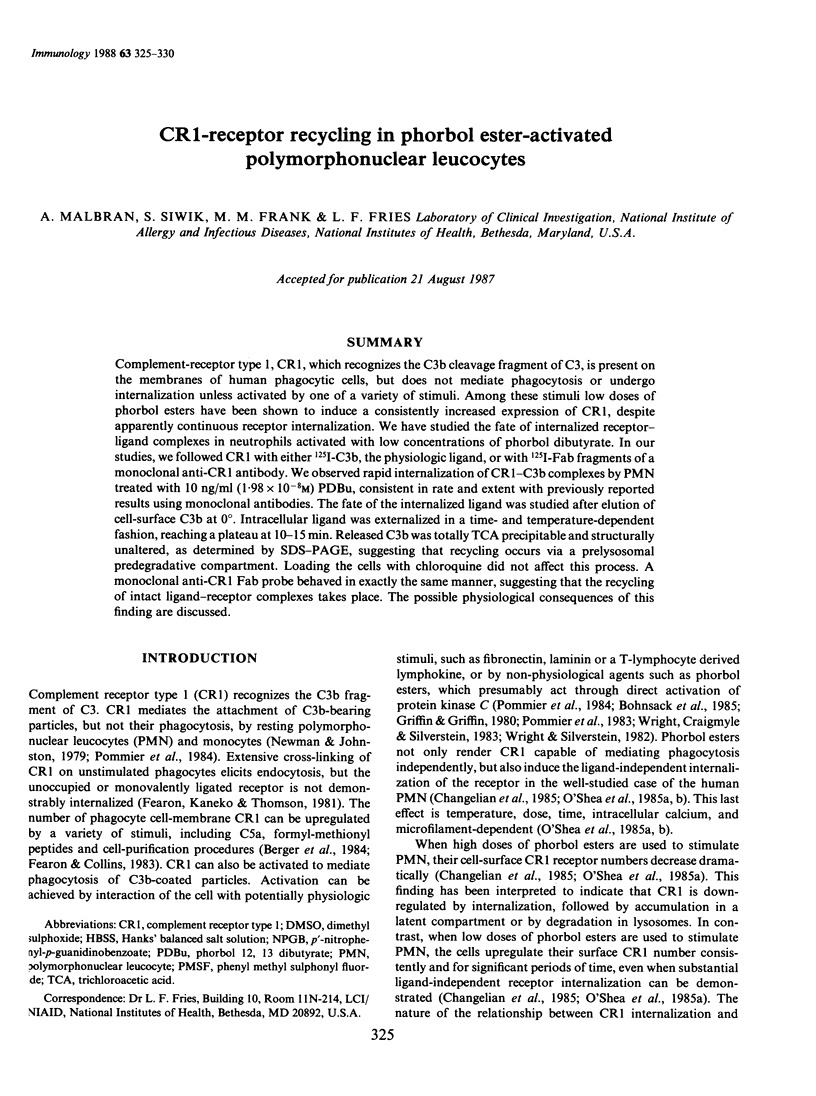
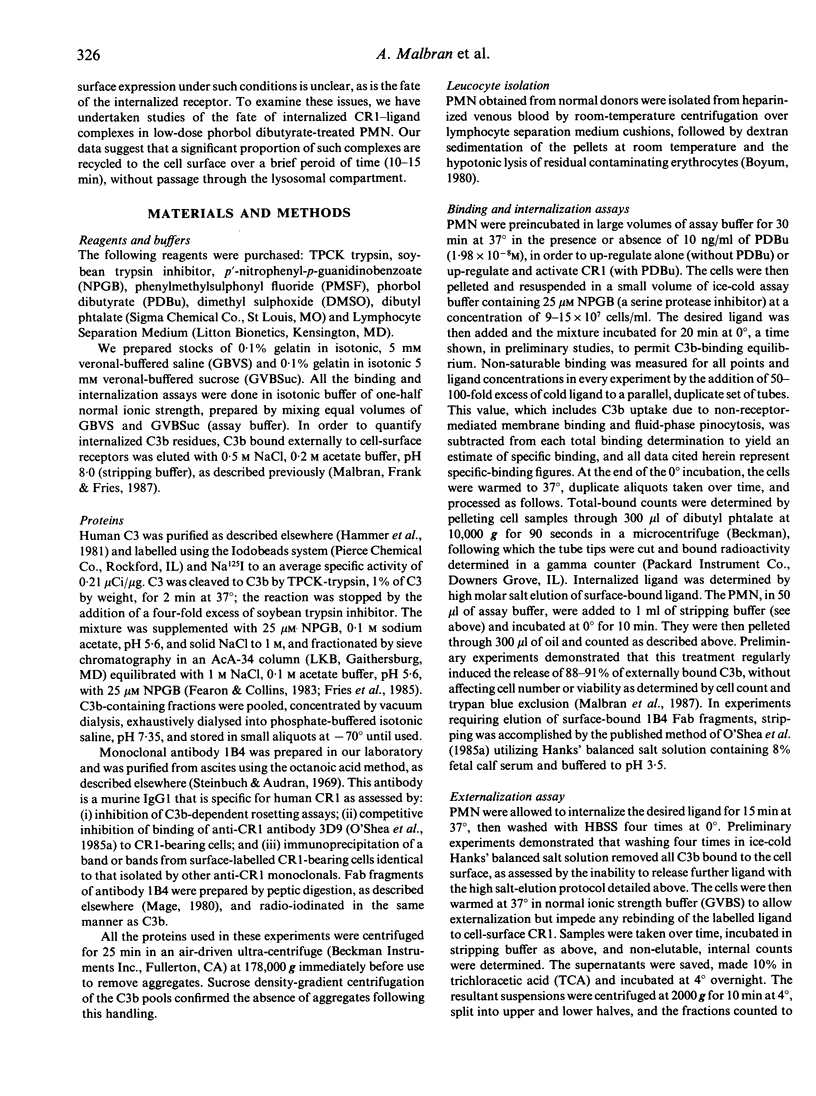
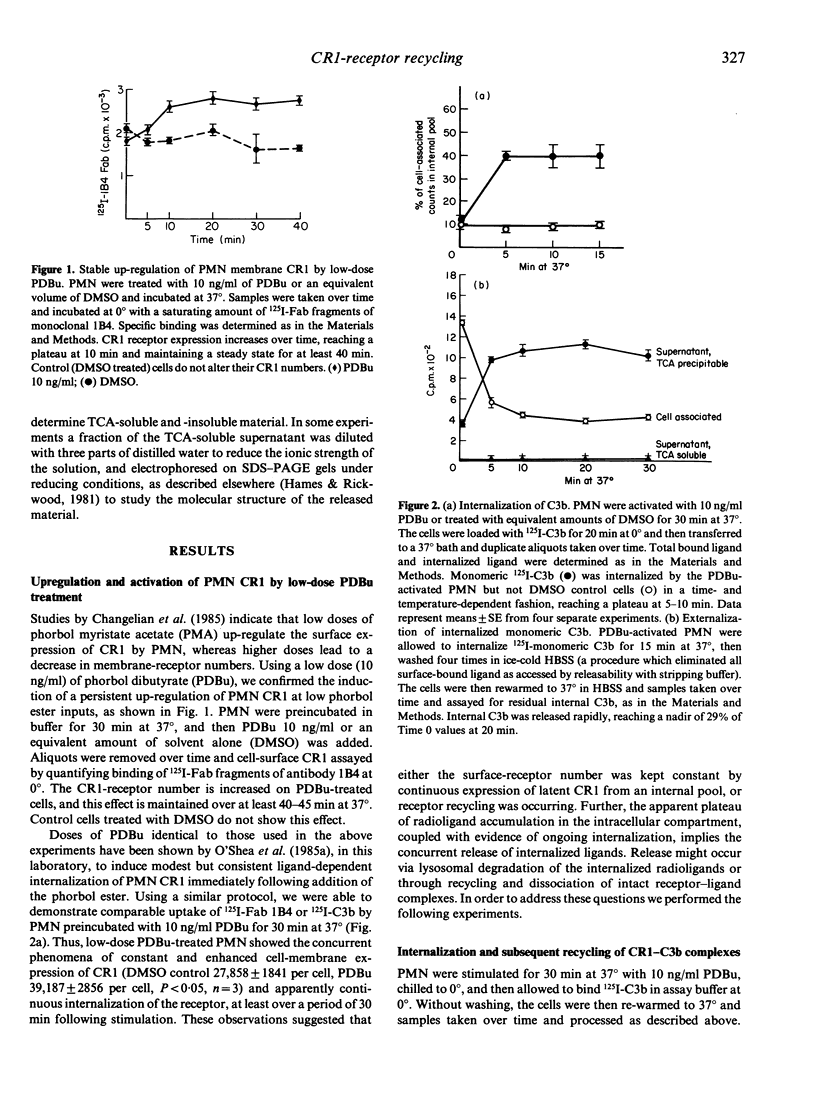
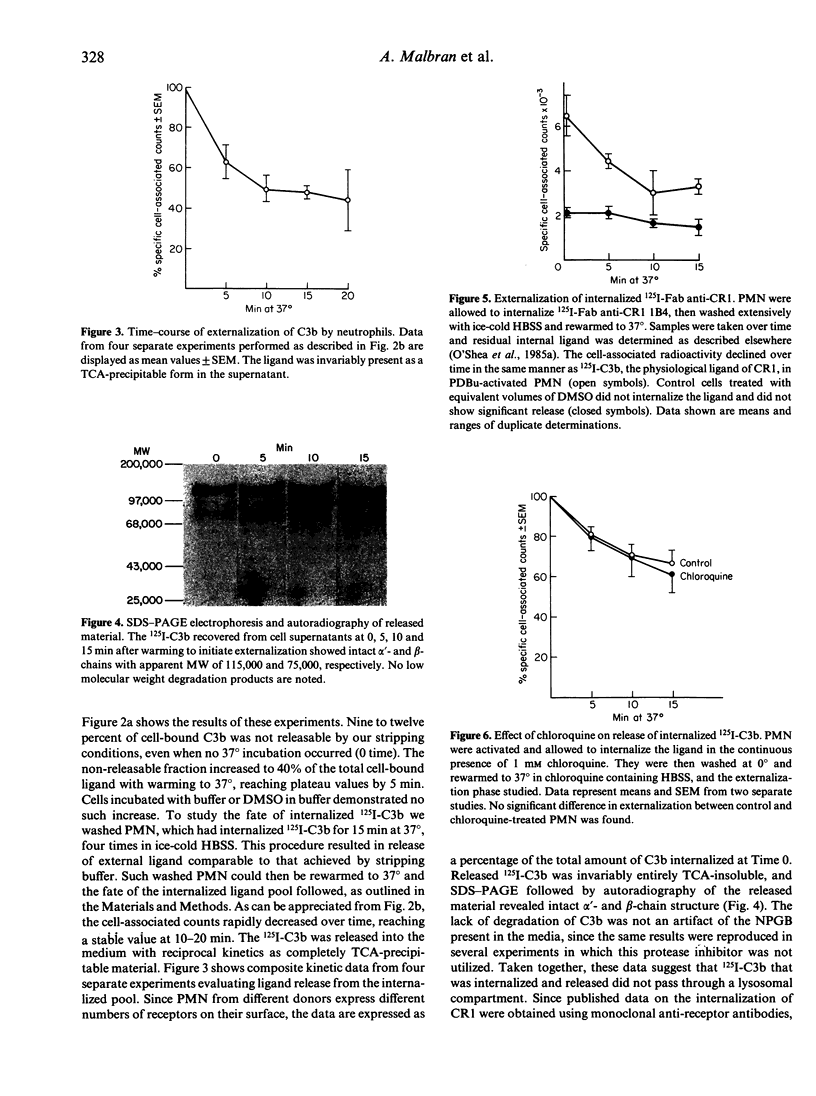
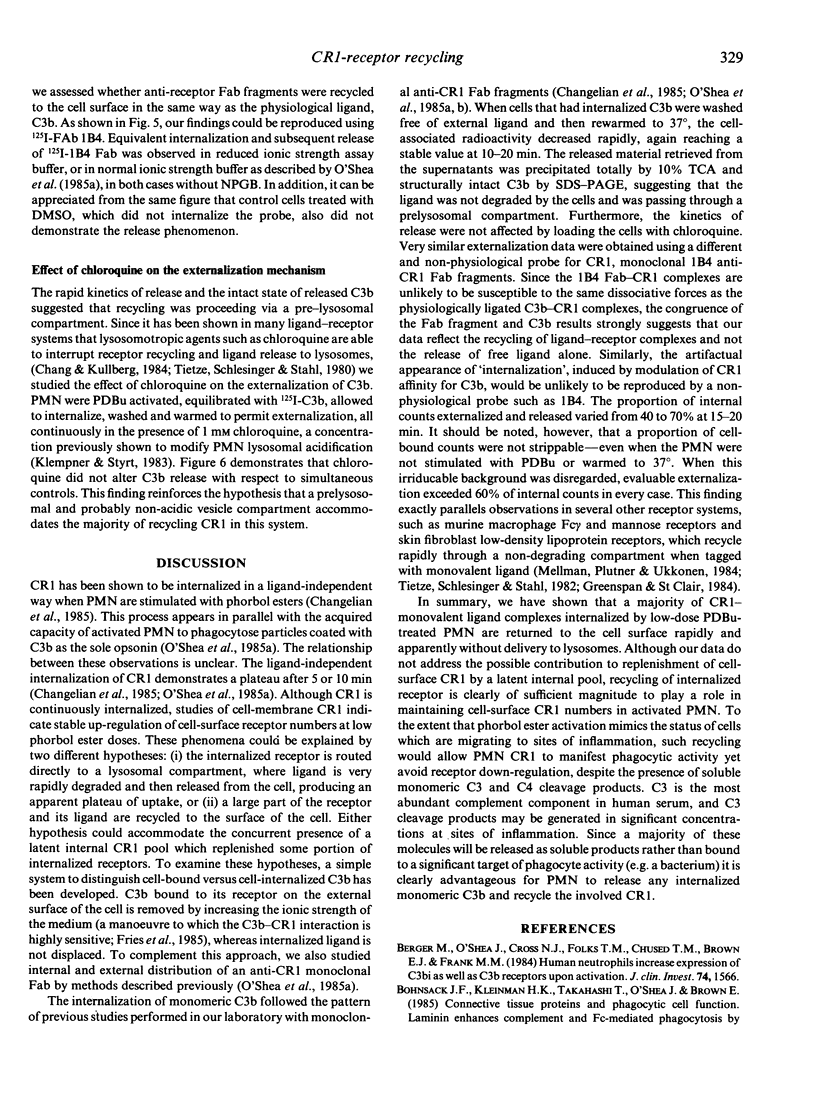
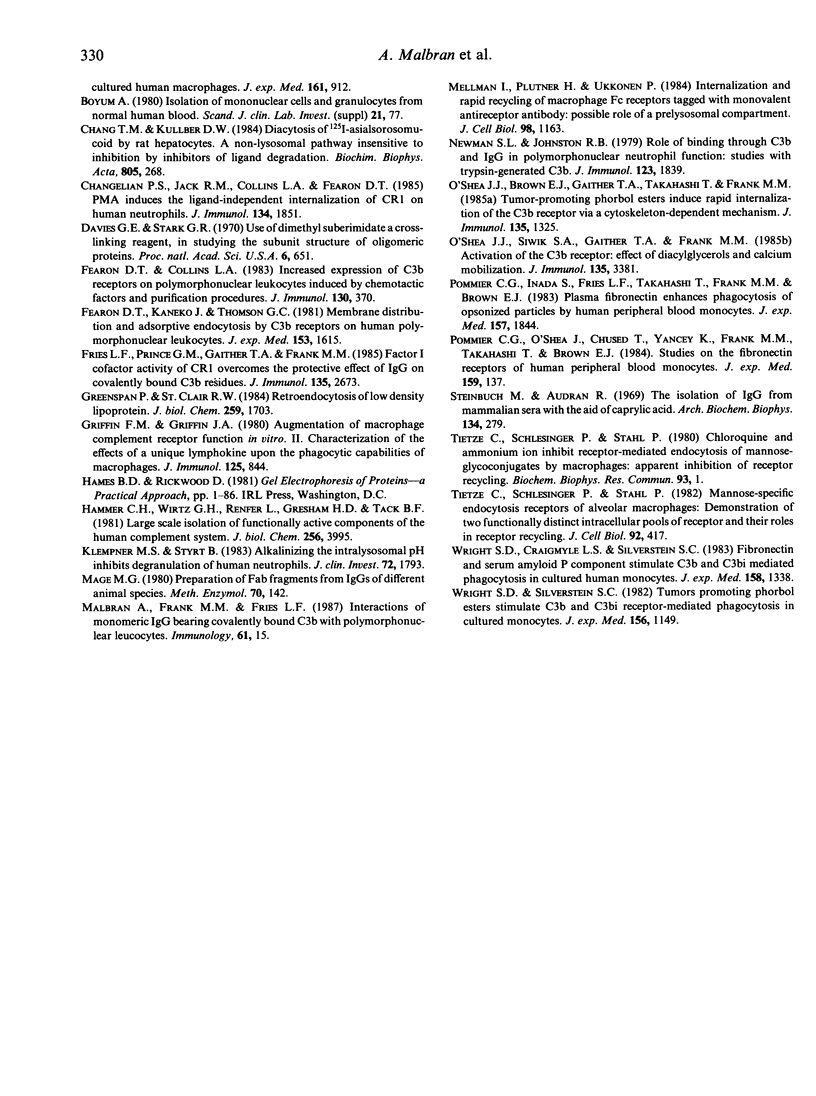
Images in this article
Selected References
These references are in PubMed. This may not be the complete list of references from this article.
- Berger M., O'Shea J., Cross A. S., Folks T. M., Chused T. M., Brown E. J., Frank M. M. Human neutrophils increase expression of C3bi as well as C3b receptors upon activation. J Clin Invest. 1984 Nov;74(5):1566–1571. doi: 10.1172/JCI111572. [DOI] [PMC free article] [PubMed] [Google Scholar]
- Bohnsack J. F., Kleinman H. K., Takahashi T., O'Shea J. J., Brown E. J. Connective tissue proteins and phagocytic cell function. Laminin enhances complement and Fc-mediated phagocytosis by cultured human macrophages. J Exp Med. 1985 May 1;161(5):912–923. doi: 10.1084/jem.161.5.912. [DOI] [PMC free article] [PubMed] [Google Scholar]
- Chang T. M., Kullberg D. W. Diacytosis of 125I-asialoorosomucoid by rat hepatocytes. A non-lysosomal pathway insensitive to inhibition by inhibitors of ligand degradation. Biochim Biophys Acta. 1984 Nov 13;805(3):268–276. doi: 10.1016/0167-4889(84)90082-x. [DOI] [PubMed] [Google Scholar]
- Changelian P. S., Jack R. M., Collins L. A., Fearon D. T. PMA induces the ligand-independent internalization of CR1 on human neutrophils. J Immunol. 1985 Mar;134(3):1851–1858. [PubMed] [Google Scholar]
- Davies G. E., Stark G. R. Use of dimethyl suberimidate, a cross-linking reagent, in studying the subunit structure of oligomeric proteins. Proc Natl Acad Sci U S A. 1970 Jul;66(3):651–656. doi: 10.1073/pnas.66.3.651. [DOI] [PMC free article] [PubMed] [Google Scholar]
- Fearon D. T., Collins L. A. Increased expression of C3b receptors on polymorphonuclear leukocytes induced by chemotactic factors and by purification procedures. J Immunol. 1983 Jan;130(1):370–375. [PubMed] [Google Scholar]
- Fearon D. T., Kaneko I., Thomson G. G. Membrane distribution and adsorptive endocytosis by C3b receptors on human polymorphonuclear leukocytes. J Exp Med. 1981 Jun 1;153(6):1615–1628. doi: 10.1084/jem.153.6.1615. [DOI] [PMC free article] [PubMed] [Google Scholar]
- Fries L. F., Prince G. M., Gaither T. A., Frank M. M. Factor I co-factor activity of CR1 overcomes the protective effect of IgG on covalently bound C3b residues. J Immunol. 1985 Oct;135(4):2673–2679. [PubMed] [Google Scholar]
- Greenspan P., St Clair R. W. Retroendocytosis of low density lipoprotein. Effect of lysosomal inhibitors on the release of undegraded 125I-low density lipoprotein of altered composition from skin fibroblasts in culture. J Biol Chem. 1984 Feb 10;259(3):1703–1713. [PubMed] [Google Scholar]
- Griffin F. M., Jr, Griffin J. A. Augmentation of macrophage complement receptor function in vitro. II. Characterization of the effects of a unique lymphokine upon the phagocytic capabilities of macrophages. J Immunol. 1980 Aug;125(2):844–849. [PubMed] [Google Scholar]
- Hammer C. H., Wirtz G. H., Renfer L., Gresham H. D., Tack B. F. Large scale isolation of functionally active components of the human complement system. J Biol Chem. 1981 Apr 25;256(8):3995–4006. [PubMed] [Google Scholar]
- Klempner M. S., Styrt B. Alkalinizing the intralysosomal pH inhibits degranulation of human neutrophils. J Clin Invest. 1983 Nov;72(5):1793–1800. doi: 10.1172/JCI111139. [DOI] [PMC free article] [PubMed] [Google Scholar]
- Mage M. G. Preparation of Fab fragments from IgGs of different animal species. Methods Enzymol. 1980;70(A):142–150. doi: 10.1016/s0076-6879(80)70045-9. [DOI] [PubMed] [Google Scholar]
- Mellman I., Plutner H., Ukkonen P. Internalization and rapid recycling of macrophage Fc receptors tagged with monovalent antireceptor antibody: possible role of a prelysosomal compartment. J Cell Biol. 1984 Apr;98(4):1163–1169. doi: 10.1083/jcb.98.4.1163. [DOI] [PMC free article] [PubMed] [Google Scholar]
- Newman S. L., Johnston R. B., Jr Role of binding through C3b and IgG in polymorphonuclear neutrophil function: studies with trypsin-generated C3b. J Immunol. 1979 Oct;123(4):1839–1846. [PubMed] [Google Scholar]
- O'Shea J. J., Brown E. J., Gaither T. A., Takahashi T., Frank M. M. Tumor-promoting phorbol esters induce rapid internalization of the C3b receptor via a cytoskeleton-dependent mechanism. J Immunol. 1985 Aug;135(2):1325–1330. [PubMed] [Google Scholar]
- O'Shea J. J., Siwik S. A., Gaither T. A., Frank M. M. Activation of the C3b receptor: effect of diacylglycerols and calcium mobilization. J Immunol. 1985 Nov;135(5):3381–3387. [PubMed] [Google Scholar]
- Pommier C. G., Inada S., Fries L. F., Takahashi T., Frank M. M., Brown E. J. Plasma fibronectin enhances phagocytosis of opsonized particles by human peripheral blood monocytes. J Exp Med. 1983 Jun 1;157(6):1844–1854. doi: 10.1084/jem.157.6.1844. [DOI] [PMC free article] [PubMed] [Google Scholar]
- Pommier C. G., O'Shea J., Chused T., Yancey K., Frank M. M., Takahashi T., Brown E. J. Studies on the fibronectin receptors of human peripheral blood leukocytes. Morphologic and functional characterization. J Exp Med. 1984 Jan 1;159(1):137–151. doi: 10.1084/jem.159.1.137. [DOI] [PMC free article] [PubMed] [Google Scholar]
- Steinbuch M., Audran R. The isolation of IgG from mammalian sera with the aid of caprylic acid. Arch Biochem Biophys. 1969 Nov;134(2):279–284. doi: 10.1016/0003-9861(69)90285-9. [DOI] [PubMed] [Google Scholar]
- Tietze C., Schlesinger P., Stahl P. Chloroquine and ammonium ion inhibit receptor-mediated endocytosis of mannose-glycoconjugates by macrophages: apparent inhibition of receptor recycling. Biochem Biophys Res Commun. 1980 Mar 13;93(1):1–8. doi: 10.1016/s0006-291x(80)80237-3. [DOI] [PubMed] [Google Scholar]
- Tietze C., Schlesinger P., Stahl P. Mannose-specific endocytosis receptor of alveolar macrophages: demonstration of two functionally distinct intracellular pools of receptor and their roles in receptor recycling. J Cell Biol. 1982 Feb;92(2):417–424. doi: 10.1083/jcb.92.2.417. [DOI] [PMC free article] [PubMed] [Google Scholar]
- Wright S. D., Craigmyle L. S., Silverstein S. C. Fibronectin and serum amyloid P component stimulate C3b- and C3bi-mediated phagocytosis in cultured human monocytes. J Exp Med. 1983 Oct 1;158(4):1338–1343. doi: 10.1084/jem.158.4.1338. [DOI] [PMC free article] [PubMed] [Google Scholar]
- Wright S. D., Silverstein S. C. Tumor-promoting phorbol esters stimulate C3b and C3b' receptor-mediated phagocytosis in cultured human monocytes. J Exp Med. 1982 Oct 1;156(4):1149–1164. doi: 10.1084/jem.156.4.1149. [DOI] [PMC free article] [PubMed] [Google Scholar]



